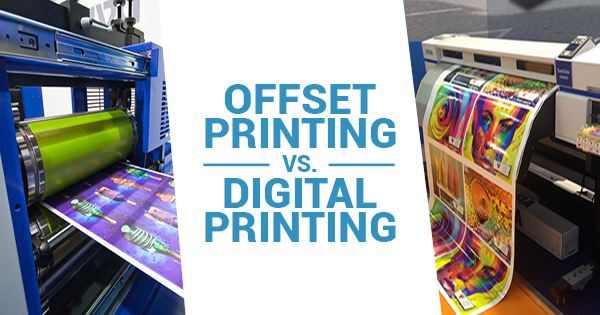
Commercial print jobs require the perfect design, colors, copy, and layout. And most importantly, you must choose the right printing process for the job. There are two main types of printing for commercial jobs: offset printing and digital printing. In this article, we’re going to cover the differences between the two processes and which one is best for certain projects.
What Is Offset Printing?
Offset printing is the most common type of printing process for high-volume commercial jobs. This printing process begins with the printer burning the design onto metal plates, making one for each color. Then, the design is transferred from the plates onto rubber rolls. After the different colors of ink are spread onto the rubber, the paper is run between the rolls. The printing paper goes through all of the rolls while layering on color and produces the final image.
Using these types of printing machines, you can expect:
- Unbeatable image quality
The quality of offset printing is reliable and you can always expect clean, distinct images or type without defects. - Better color fidelity
This refers to both the accuracy of the colors and their balance within the design. Due to the ability to mix custom colors, offset printing will always get the colors just right. - Ability to print on almost any kind of material
Whether you’re doing poster printing, vinyl printing, or large format printing, this printing process works on a wide variety of materials. - Reduced costs for high volume printing
If you need a large amount of material printed, offset printing will save you money in the long run.
However, offset printing may not be great for low-volume jobs, as it may cost more to invest in the equipment and material. Additionally, it is harder to fix an error if a typo on a plate is not caught early on. This may ruin a batch of printed materials, requiring you to start over again.
What Is Digital Printing?
Digital printing skips the proofs, plates, and rubber rolls to apply a design directly to the printing surface. This printing process uses toner and combines a mixture of Cyan, Magenta, Yellow, and Black dots in order to create the required colors. The printer in your home or office likely uses a similar technique.
When using digital printing machines, you can expect:
A faster turnaround time
Without the long setup process, a digitally printed project can be done more more quickly.
- Identical prints every time
Since there is no chance of imbalances in water and ink, you have a lower risk of variations between prints. - Reduced costs for low amounts of prints
For low volume jobs, spending less on equipment and material by digitally printing the project will save you money. - Making edits with ease
Changing information between batches can be done by simply making edits to the digital copy of the project.
With that in mind, it’s important to remember that digital printing offers fewer materials you can print on. Additionally, because digital print jobs can’t exactly match colors, you may experience less color fidelity along with a slightly lower quality of the final prints.
Which Is the Better Option?
Since both offset printing and digital printing have many benefits to offer, it really comes down to the type of project. For mass printing, like brochures, newspapers, or posters, offset printing will give you a higher-quality job at a lower cost. On the other hand, if you need something done quickly and efficiently, digital printing may be the way to go.
But no matter the printing process, print material is often still preferred over digital material. In fact, a survey conducted in August 2013 found that 70% of participants would be extremely likely to reference a print directory during an emergency. While digital material may sometimes be more convenient, consumers still prefer that feeling of holding paper in their hands.
